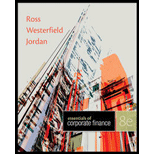
To determine: The current yield, the yield to maturity, and the effective annual yield
Introduction:
Yields refer to the
The current yield of the bond is the annual coupon of the bond divided by the
Answer to Problem 18QP
The current yield on the bond is 7.73 percent. The yield to maturity of the bond is 7.78 percent. The effective annual yield is 7.93 percent.
Explanation of Solution
Given information:
Company P issued bonds that have a coupon rate of 7.5 percent. The remaining life of the bonds is 22 years. The present market value of the bond is 97 percent of the face value. The bonds pay coupons semiannually. Assume that the face value of the bonds is $1,000.
Formula:
The formula to calculate annual coupon payment:
The formula to calculate the current price of the bond:
The formula to calculate the current yield:
The formula to calculate the yield to maturity:
Where,
“C” refers to the coupon paid per period
“F” refers to the face value paid at maturity
“r” refers to the yield to maturity
“t” refers to the periods to maturity
The formula to calculate the effective yield:
Where,
“r” refers to the yield to maturity
“t” refers to the periods to maturity
Compute the annual coupon payment:
Hence, the annual coupon payment is $75.
Compute the current price of the bond:
Hence, the current price of the bond is $970.
Compute the current yield:
Hence, the current yield is 7.73%.
Compute the semiannual yield to maturity of the bond as follows:
The bond pays the coupons semiannually. The annual coupon payment is $75. However, the bondholder will receive the same is two equal installments. Hence, semiannual coupon payment or the 6-month coupon payment is $37.50
The remaining time to maturity is 22 years. As the coupon payment is semiannual, the semiannual periods to maturity are 44
Finding “r” in Equation (1) would give the semiannual yield to maturity. However, it is difficult to simplify the above the equation. Hence, the only method to solve for “r” is the trial and error method.
The first step in trial and error method is to identify the discount rate that needs to be used. The bond sells at a premium in the market if the market rates (Yield to maturity) are lower than the coupon rate. Similarly, the bond sells at a discount if the market rate (Yield to maturity) is greater than the coupon rate.
In the given information, the bond sells at a discount because the market value of the bond is lower than its face value. Hence, substitute “r” with a rate that is greater than the coupon rate until one obtains the bond value close to $970.
The coupon rate of 7.5 percent is an annual rate. The semiannual coupon rate is 3.75 percent
The attempt under the trial and error method using 3.89 percent as “r”:
The current price of the bond is $969.90, when “r” is 3.89 percent. This value is more close to $970. Hence, 3.89 percent is the semiannual yield to maturity.
Compute the annual yield to maturity:
Hence, the yield to maturity is 7.78 percent.
Compute the effective annual yield:
The semiannual yield to maturity (r) is 3.89 percent, and the semiannual periods (t) in one year are “two”.
Hence, the effective annual yield is 7.93 percent.
Want to see more full solutions like this?
Chapter 6 Solutions
Essentials of Corporate Finance
- A corporation buys on terms of 2/8, net 45 days, it does not take discountes, and it actually pays after 62 days, what is the effective annual percentage cost of its non-free trade credit? Use a 365-day year) keep to the 6th decimal place for accuracyarrow_forward. If a stock pays an annual dividend of $3 and the required rate of return is 10%, what is its value using the dividend discount model? A) $30B) $25C) $33D) $300arrow_forward7. Calculate the present value of $1,000 received in 3 years at 8% discount rate. need a ai ...??arrow_forward
- 6. If sales are $100,000 and net income is $20,000, what is the profit margin? need a helpful..???arrow_forward5. Calculate WACC for a company with 50% debt (cost 6%) and 50% equity (cost 10%). Need a helpfully...???arrow_forward2. A bond pays $50 annual interest with a face value of $1,000. What is the coupon rate? need a helfuarrow_forward
- 3. If EPS is $5 and the stock price is $50, what is the P/E ratio? Need a helpful..?????arrow_forward1. Calculate the future value of $1,000 invested at 5% interest for 2 years. no gpt ..???arrow_forward4. A savings account earns an annual interest rate of 2%. If you deposit $1,000, how much interest will you earn in one year? correct solution????arrow_forward
- 1. If a stock's current price is $50 and it increases by 10%, what is the new price? Need a helpful..???arrow_forward2. A bond has a face value of $1,000 and a coupon rate of 5%. What is the annual interest payment? need a helpful????arrow_forward4. A savings account earns an annual interest rate of 2%. If you deposit $1,000, how much interest will you earn in one year? step by step solution???arrow_forward
 Essentials Of InvestmentsFinanceISBN:9781260013924Author:Bodie, Zvi, Kane, Alex, MARCUS, Alan J.Publisher:Mcgraw-hill Education,
Essentials Of InvestmentsFinanceISBN:9781260013924Author:Bodie, Zvi, Kane, Alex, MARCUS, Alan J.Publisher:Mcgraw-hill Education,

 Foundations Of FinanceFinanceISBN:9780134897264Author:KEOWN, Arthur J., Martin, John D., PETTY, J. WilliamPublisher:Pearson,
Foundations Of FinanceFinanceISBN:9780134897264Author:KEOWN, Arthur J., Martin, John D., PETTY, J. WilliamPublisher:Pearson, Fundamentals of Financial Management (MindTap Cou...FinanceISBN:9781337395250Author:Eugene F. Brigham, Joel F. HoustonPublisher:Cengage Learning
Fundamentals of Financial Management (MindTap Cou...FinanceISBN:9781337395250Author:Eugene F. Brigham, Joel F. HoustonPublisher:Cengage Learning Corporate Finance (The Mcgraw-hill/Irwin Series i...FinanceISBN:9780077861759Author:Stephen A. Ross Franco Modigliani Professor of Financial Economics Professor, Randolph W Westerfield Robert R. Dockson Deans Chair in Bus. Admin., Jeffrey Jaffe, Bradford D Jordan ProfessorPublisher:McGraw-Hill Education
Corporate Finance (The Mcgraw-hill/Irwin Series i...FinanceISBN:9780077861759Author:Stephen A. Ross Franco Modigliani Professor of Financial Economics Professor, Randolph W Westerfield Robert R. Dockson Deans Chair in Bus. Admin., Jeffrey Jaffe, Bradford D Jordan ProfessorPublisher:McGraw-Hill Education





